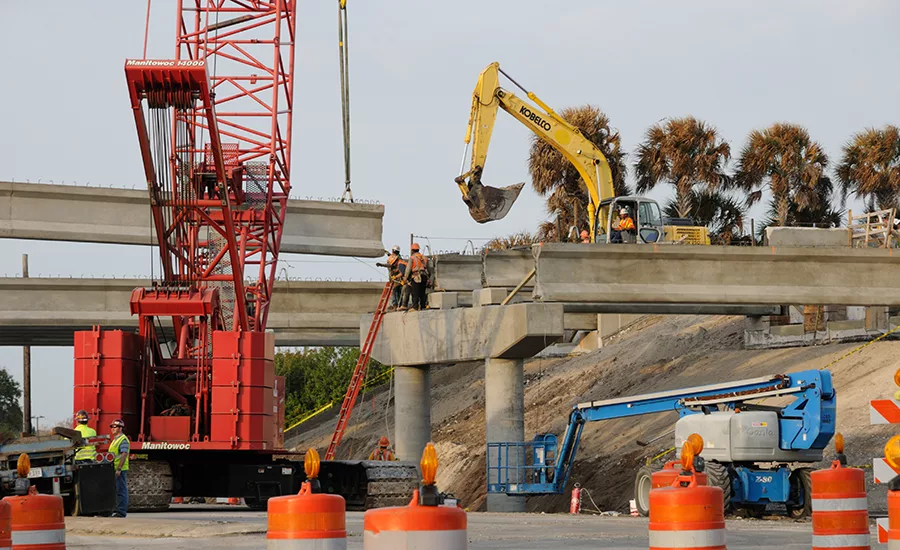Trump Infrastructure Plan Slowly, Steadily Takes Shape
Proposal for $1T Investment Could Create Drilling Jobs

The construction industry, including foundations and geotech drillers, might have to wait on President Donald J. Trump’s infrastructure plan.
I mentioned the plan a couple months ago, but wanted to dig into it a bit and let readers know where it stands as Trump winds his way through his first 100 days. It appears delayed by other top priorities, like the Affordable Care Act repeal and proposed tax reform.
Any major infrastructure bill, particularly one with $1-trillion ambitions, would give a huge boost to U.S. construction. It would mean jobs and contracts for National Driller readers working to support major bridge, highway, dam, port and other construction projects in every state.
In other words, it’s a big deal.
Behind the Scenes
The president reiterated his promise to push infrastructure in his January address to Congress. Since then, he’s said he wants to begin work on getting his plan into law after health care and tax reform. The administration also asked states, through the National Governors Association, for a list of “shovel ready” projects. The hundreds of projects submitted as state priorities in transportation, water and energy infrastructure show the strong interest this plan.
Trump has also asked his regulatory agencies, like the EPA, for ideas about how to grease the skids for approvals to get things at the federal level moving quickly once the plan is in place. By the same token, he wants his plan to favor projects that states say they can greenlight quickly. That likely means more renovation of existing infrastructure than new projects.
So, When Do We Start?
The short answer? Any major projects created by Trump’s infrastructure plan likely wouldn’t happen until at least 2018.
The long answer? We follow this closely here at NDHQ, and we’ve seen mixed messages on when the infrastructure proposal, whatever final form it takes, would make it to Congress. As recently as this week, the GOP chair of the Transportation and Infrastructure Committee, Rep. Bill Shuster (R-Pa.) told The Hill that the proposal may end up in the reauthorization bill for the FAA, which has to pass by the end of September.
There are two reasons for this. A major infrastructure bill spends money. The White House believes $137 billion in federal spending can attract enough private investment to add up to $1 trillion in investment. That $137 billion isn’t much, considering the size of the federal budget, but any spending bill can be filibustered.
Which brings us to the second reason: The FAA reauthorization is a must-pass bill. Democrats in Congress have been cool to Trump’s agenda so far. But several have said they could support an infrastructure plan, depending on the details. Regardless of those details or what happens to Democratic receptiveness to Trump’s ideas between now and late summer, wrapping infrastructure into the FAA bill puts a lot of pressure on lawmakers to pass it as a package.
We’ve also seen mention that a bill may not happen this year. In fact, stocks are bearish on any plan passing this year.
There's a lot of uncertainty about the exact timing of the infrastructure proposal. But, if it does pass in September, or even separately this summer, the greater part of the 2017 construction season will have already passed. Assuming it does pass this year, though, look for projects to begin in spring 2018.
Paying for Infrastructure
This is the $1 trillion question. The answer is public/private partnerships. The outlines of the proposal lay out $137 billion in federal tax credits that the administration expects will attract enough private investment to equal $1 trillion in infrastructure spending.
Take, for example, a span of highway that needs work. Private companies are enticed with tax credits to get the work done. Once the highway is put into service, those companies recoup their investments through tolls. The work creates jobs (and subcontracts for drillers), and the taxes those workers and their employers pay on the newly created economic activity pay back the initial $137 billion investment in the tax credits.
It all sounds like a win-win. But this kind of funding model has often bogged down in the U.S. Voters can look skeptically on privately run roads. Each state also has different rules for public-private projects. Still, there are a lot of ideas for making the whole thing cheaper and for finding ways to work with the states themselves to come along.
What Do You Think?
When I last wrote about this, I got a nice letter from a reader calling Trump’s talk of infrastructure “music to my ears.” He then went on to lament that the president has so far put his efforts into “perceived partisan” issues like his border wall proposal, and not something bipartisan like infrastructure. What do you think? Are you eager for the infrastructure ball to start rolling? Or are you just optimistic that the economy seems to be picking up, and don’t mind waiting? Send thoughts, ideas and rants to verduscoj@bnpmedia.com.
